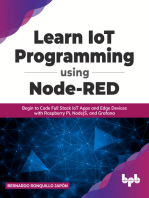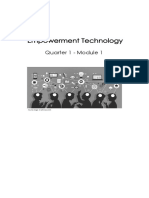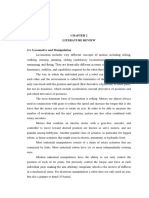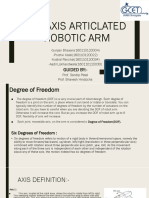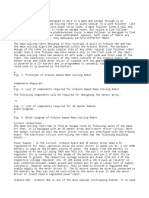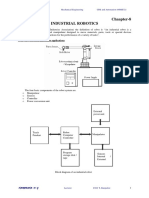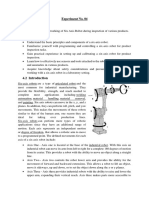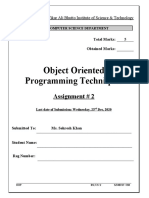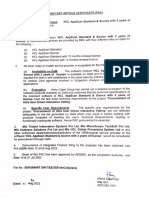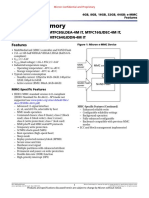2018-Arduino Based 6DoF Robot Using LabVIEW
Uploaded by
Alfredo Galeano2018-Arduino Based 6DoF Robot Using LabVIEW
Uploaded by
Alfredo GaleanoSee discussions, stats, and author profiles for this publication at: https://www.researchgate.
net/publication/341296693
Arduino based 6DoF Robot using LabVIEW
Research · January 2018
DOI: 10.13140/RG.2.2.12326.55363
CITATIONS READS
2 304
1 author:
RATHY G A
National Institute of Technical Teachers Training and Research Chennai
8 PUBLICATIONS 3 CITATIONS
SEE PROFILE
Some of the authors of this publication are also working on these related projects:
Estimation of SoC using SVM regression technique for an Efficient Electric Vehicle Battery Management System using c-RIO DAQ View project
Outcome based Education View project
All content following this page was uploaded by RATHY G A on 11 May 2020.
The user has requested enhancement of the downloaded file.
Rathy G. A, Balaji Aravind, International Journal of Advance Research and Development.
ISSN: 2454-132X
Impact factor: 4.295
(Volume 4, Issue 1)
Available online at www.ijariit.com
Arduino based 6DoF Robot using LabVIEW
G. A Rathy
Aravind Balaji
rathysanju@gmail.com
balajiaravi@gmail.com
National Institute Of Technical Teachers Training
Bharathi Enterprises Chennai, Tamil Nadu
and Research, Taramani, Tamil Nadu
ABSTRACT
This paper presents a development of a 6-axis robotic arm controller (i.e) six degrees or axis of freedom (6DoF) refers to the
freedom of movement of a rigid body in three-dimensional space. Each axis of the robot are been controlled using a servo motor.
The position of each axis can be derived from the Pulse Width modulated wave which is applied to each servo motor, at each
and every axis. The controller is divided into two major parts namely power block and control block. Power block is carried out
by the Arduino controller and the control block is carried out by LabVIEW similarly control are been sent serially thought
Arduino board to control the position of the servo motor
Keywords: LabVIEW, Arduino, Servo Motor, Pulse Width Modulation, 6-axis Robotic Arm Controller.
1. INTRODUCTION
A robotic arm is a type of mechanical arm, usually programmable, with similar functions to a human arm; the arm may be the sum
total of the mechanism or may be part of a more complex robot. The links of such a manipulator are connected by joints allowing
either rotational motion (such as in an articulated robot) or translational (linear) displacement. Serial and parallel manipulator
systems are generally designed to position an end-effector with six degrees of freedom, consisting of three in translation and three
in orientation. This provides a direct relationship between actuator positions and the configuration of the manipulator. Robot arms
are described by their degrees of freedom. This number typically refers to the number of single-axis rotational joints in the arm,
where a higher number indicates an increased flexibility in positioning a tool. This is a practical metric, in contrast to the abstract
definition of degrees of freedom which measures the aggregate positioning capability of a system.
The end effectors, or robotic hand, can be designed to perform any desired task such as welding, gripping, spinning etc., depending
on the application. For example, robot arms in automotive assembly lines perform a variety of tasks such as welding and parts
rotation and placement during assembly. In some circumstances, close emulation of the human hand is desired, as in robots designed
to conduct bomb disarmament and disposal.
© 2018, www.IJARIIT.com All Rights Reserved Page | 354
Rathy G. A, Balaji Aravind, International Journal of Advance Research and Development.
Fig -1: The six degrees of freedom: forward/back,
Up/down, left/right, yaw, pitch, and roll
The figure 1 given above shows the motion movement in each axis an example of six degrees of freedom movement is the motion
of a ship at sea. It is described as.
Translational envelopes:
Moving forward and backward on the X-axis. (Surge)
Moving left and right on the Y-axis. (Sway)
Moving up and down on the Z-axis. (Heave)
Rotational envelopes:
Tilting side to side on the X-axis. (Roll)
Tilting forward and backward on the Y-axis. (Pitch)
Turning left and right on the Z-axis. (Yaw)
1.1 Arduino
Arduino is an open-source electronics platform based on easy-to-use hardware and software. Arduino boards are able to read inputs
- light on a sensor, a finger on a button, or a Twitter message - and turn it into an output - activating a motor, turning on an LED, by
sending set of instructions to the microcontroller on the board
Fig -2 Arduino UNO Description
Arduino can interact with buttons, LEDs, motors, speakers, GPS units, cameras, the internet, and even your smart-phone. Arduino
Uno is a microcontroller board based on the ATmega328P (datasheet). It has 14 digital input/output pins (of which 6 can be used as
PWM outputs), 6 analog inputs, a 16 MHz quartz crystal, a USB connection, a power jack, an ICSP header and a reset button.
© 2018, www.IJARIIT.com All Rights Reserved Page | 355
Rathy G. A, Balaji Aravind, International Journal of Advance Research and Development.
It contains everything needed to support the microcontroller; simply connect it to a computer with a USB cable or power it with an
AC-to-DC adapter or battery to get started. Figure 2 shows the parts of Arduino uno controller.
1.2 Arduino Sensor Shield v5.0
Fig -3 Arduino UNO Sensor shield v5
Figure 3 shows the Arduino Uno sensor shield, which is very useful as a connection point for the many interfaces that can be plugged
into the Arduino. Using a sensor shield gives you one +5V (Vcc) and one 0V (Gnd) for every Arduino signal pin. Series of servo
motor can be connected easily using such shields and the common power pins are connected to provide the supply power to the
servo motors. Servos come with a 3 way socket that plugs straight onto the Sensor Shield G goes to the Brown or Black wire, V
goes to the (middle) Red wire, S goes to the Orange wire The good news is as the +5V is in the middle, things will not blow up if it
is wired the wrong way round, the servo just will not work until it is plugged in correctly.
1.3 LabVIEW
LabVIEW, short for Laboratory Virtual Instrument Engineering Workbench, is a programming environment in which you create
programs using a graphical notation (connecting functional nodes via wires through which data flows); in this regard, it differs from
traditional programming languages like C, C++, or Java, in which you program with text. However, LabVIEW is much more than
a programming language. It is an interactive program development and execution system designed for people, like scientists and
engineers, who need to program as part of their jobs. The LabVIEW development environment works on computers running
Windows, Mac OS X, or Linux. LabVIEW can create programs that run on those platforms, as well as Microsoft Pocket PC,
Microsoft Windows CE, Palm OS, and a variety of embedded platforms, including Field Programmable Gate Arrays (FPGAs),
Digital Signal Processors (DSPs), and microprocessors.
2. IMPLEMENTATION OF 6DOF USING LABVIEW USING ARDUINO
Arduino is used as a Data acquisition device to measure, control, monitor different devices and sensors , it is easy to learn Graphical
programming than normal programming, this Graphical programming takes less time than usual arduino programming a firmware
is been downloaded on to the arduino before interfacing. LabVIEW acts as a graphical user interface (GUI) which provides the
control to the servo using Arduino board this can be achieved using a tool called LabVIEW interface for arduino (LIFA) which
makes the data transfer easy between arduino and LabVIEW to control the servo motor.The six servo motor are been connect to the
six PWM outputs of the arduino uno whose duty cycle such as angular position are been controlled by the LabVIEW and sequence
of operations are been performed using LabVIEW. Figure 4 shows the 6DoF using Arduino and LabVIEW.
Fig -4: Implementation of 6DoF using LabVIEW using Arduino.
© 2018, www.IJARIIT.com All Rights Reserved Page | 356
Rathy G. A, Balaji Aravind, International Journal of Advance Research and Development.
2.1 LabVIEW Software Implementation
LabVIEW acts as a GUI which is used to monitor and control the 6DoF robot the LabVIEW is basically of two windows namely
front panel which is the user interface and the block diagram window which is the programming part for the desired application.
Arduino is been interfaced with LabVIEW using the LIFA tool which is to be installed and once installed the desired function blocks
will be available for programming.
The figure 5 given below shows the Front panel implementation in which separate control for each servo motor is been provided
using knobs for all the six axes such as Grip, twist, wrist, Forward/Reverse, Top/Bottom, Rotation and independent indicators are
been provided for the exact angular location of each servo motors separate control has been giving to extend the number of servos,
here upto 15 servos can be connected using this tool. The programming has been done in such a way the pick and place operation
is been done by selecting the ring menu in which the process can be selected and the speed of the motor can be controlled by varying
the delay between each sequence.
Fig -5: Implementation of Front Panel
The figure 6 given below shows the block diagram implementation in which the desired logics to be performed is implemented.
Initially, the communication is been initialized and the desired com is been selected in which the arduino is connected. The Number
of Servos to be used is been selected using a block which is been indicated in the front panel for manual selection with labels for
each servo are given to indicate which servo is been provided with the control signal case structure are been provided perform
sequential and manual control of the servo motor and emergency stop sequence are been provided to shut the process of during
emergency situation.
Fig -6 Implementation of Block Diagram
2.2 Hardware Implementation
The figure 7 given below shows the hardware implementation of a six axis robot using arduino uno. Here the servo based six axes
is used with each servo is of 20kg torque which are been placed in steel assembly for rigidity and end actuator are been provides as
a gripper for picking and placing application the servo motor is controlled by Arduino using the sensor shield V5.0 which is been
stacked onto the arduino which provides the control signal and power source for the servo motor external 5 v power source of high
current such as 40 AH is provided to supply high current to the servo motors.
© 2018, www.IJARIIT.com All Rights Reserved Page | 357
Rathy G. A, Balaji Aravind, International Journal of Advance Research and Development.
Fig -7 Hardware Implementation
3. RESULT
The figure 8 give below show the output result of the GUI (Graphical User Interface) in which the pick operation is been select and
a perfected constant value for each servo are loaded into the arduino for each servo motor and the operation of pick is executed
and the number of servos to be controlled are mentioned the desired angle of each servo are indicated in gauge and digital indicators
and the sequence of pick operation in been done serially one by one the operation can be change from pick to place to manually
control by selecting the Ring menu.
Fig -8 Output Result
4. CONCLUSION
Due to the growing demand for natural Human Machine Interfaces and robot intuitive programming platforms, a robotic system
that allows users to control an industrial robot. Thus in this paper, the implementation of 6DoF (6 degrees of Freedom) based robot
using arduino under the LabVIEW platform has been carried out, which makes the hardware and software more easy and effective.
Apart from pick and place, 3D printing can also be done in future scope by the same technique.
5. REFERENCE
[1] J. H. JU, "A Study on error Analysis and Hybrid Motion Control of LabVIEW® -based 3-axis SCARA Robot", School of
Mechatronics, Changwon National University, 2008.
[2] Ashraf Elfasakhany, Eduardo Yanez, Karen Baylon, Ricardo Salgado, Design and Development of a Competitive Low-Cost
Robot Arm with Four Degrees of Freedom, Modern Mechanical Engineering, 1, November 2011, 47-55
[3] S. Calinon, and A. Billard, “Active teaching in robot programming by demonstration,” in 16th IEEE International Symposium
on Robot and Human interactive Communication, RO-MAN 2007, pp. 702-707,
Jeju Island, Korea, 2008.
[4] J. N. Pires, “Robot-by-voice: Experiments on commanding an industrial robot using the human voice,” in Industrial Robot, An
International Journal, vol. 32, no.6, pp. 505-511, Emerald, 2005.
[5] I. Mihara, Y. Yamauchi, and M. Doi, “A real-time vision-based interface using motion processor and applications to robotics,”
in Systems and Computers in Japan, vol. 34, pp. 10-19, 2003.
[6]SHIN, K. G. – MCKAY, N. D. (1985): Minimum-Time Control of Robotics Manipulators with Geometric Path Constraints,
IEEE of Automatic Control. AC-30, 6, pp.531–541.
[7] SHIN, K. G.: Trajectory Planning for Robot Control: A Control System Perspective, Control and Dynamic System Series,
Advances in Robotics System, 1991, pp. 105–146 (Academic Press Inc.).
[8] National Instruments Corporation. "Motion control Fundamentals course Manual", 2002-2004.
[9] Robotics & Automation Magazine, vol. 12, no. 3, pp. 16-23, 2005.
© 2018, www.IJARIIT.com All Rights Reserved Page | 358
View publication stats
You might also like
- Learn IoT Programming Using Node-RED: Begin to Code Full Stack IoT Apps and Edge Devices with Raspberry Pi, NodeJS, and GrafanaFrom EverandLearn IoT Programming Using Node-RED: Begin to Code Full Stack IoT Apps and Edge Devices with Raspberry Pi, NodeJS, and GrafanaNo ratings yet
- Six Axis Articlated Robotic Arm 2nd PresentationNo ratings yetSix Axis Articlated Robotic Arm 2nd Presentation17 pages
- robotic-manipulator-robotic-arm-IJERTV10IS090088No ratings yetrobotic-manipulator-robotic-arm-IJERTV10IS0900883 pages
- Color Based 6 DOF Sorting Robot With Real-Time Object DetectionNo ratings yetColor Based 6 DOF Sorting Robot With Real-Time Object Detection3 pages
- Bluetooth Controlled Arduino Based Robotic Arm: Srija Dasgupta Avirup Ghosh Debraj ChatterjeeNo ratings yetBluetooth Controlled Arduino Based Robotic Arm: Srija Dasgupta Avirup Ghosh Debraj Chatterjee6 pages
- Gesture Control of Robotic Arm: Institute of Research AdvancesNo ratings yetGesture Control of Robotic Arm: Institute of Research Advances9 pages
- Wireless 4 Dof Robotic Arm Using Mega 2560-1No ratings yetWireless 4 Dof Robotic Arm Using Mega 2560-111 pages
- Pick and Place Robot Using Arduino Using Bluetooth71% (7)Pick and Place Robot Using Arduino Using Bluetooth39 pages
- Pick and Place Robot Using Arduino Using Bluetooth PDFNo ratings yetPick and Place Robot Using Arduino Using Bluetooth PDF39 pages
- Electrical and Electronics Engineering Seminar Topic: Hand Gesture Robotic Arm100% (1)Electrical and Electronics Engineering Seminar Topic: Hand Gesture Robotic Arm27 pages
- Mechatronics Assignment by Waqas Ali Tunio (07ME34) QUEST Nawabshah100% (1)Mechatronics Assignment by Waqas Ali Tunio (07ME34) QUEST Nawabshah14 pages
- Design and Development of A Servo Control System For Arduino Uno Based Bird Drone MechanicsNo ratings yetDesign and Development of A Servo Control System For Arduino Uno Based Bird Drone Mechanics6 pages
- IRJET Android Based Pick and Place RobotNo ratings yetIRJET Android Based Pick and Place Robot8 pages
- Design of 4-DOF manipulator based on ArduinoNo ratings yetDesign of 4-DOF manipulator based on Arduino4 pages
- Assessment Criteria For Mid-Term Assessment TEQIP-III Technology Robotics and AutomationNo ratings yetAssessment Criteria For Mid-Term Assessment TEQIP-III Technology Robotics and Automation30 pages
- Development of Robotic Arm Using Arduino Uno: Priyambada Mishra, Riki Patel, Trushit Upadhyaya, Arpan DesaiNo ratings yetDevelopment of Robotic Arm Using Arduino Uno: Priyambada Mishra, Riki Patel, Trushit Upadhyaya, Arpan Desai9 pages
- Kinematic Analysis of Open-Source 5 DoF Robot Arm (#843139) - 1456378No ratings yetKinematic Analysis of Open-Source 5 DoF Robot Arm (#843139) - 145637810 pages
- Accelerometer-Based Control of An Industrial Robotic ArmNo ratings yetAccelerometer-Based Control of An Industrial Robotic Arm6 pages
- Keyboard-Based Control and Simulation of 6-DOF Robotic Arm Using ROSNo ratings yetKeyboard-Based Control and Simulation of 6-DOF Robotic Arm Using ROS5 pages
- IRJET - Gesture Controlled Robot With Obs PDFNo ratings yetIRJET - Gesture Controlled Robot With Obs PDF3 pages
- 6 Degrees of Freedom Robotic Arm Gripper MMNo ratings yet6 Degrees of Freedom Robotic Arm Gripper MM15 pages
- Joystick Controlled Industrial Robotic SystemNo ratings yetJoystick Controlled Industrial Robotic System4 pages
- Arduino Solutions Handbook: Design interesting DIY projects using Arduino Uno, C and C++ (English Edition)From EverandArduino Solutions Handbook: Design interesting DIY projects using Arduino Uno, C and C++ (English Edition)No ratings yet
- iSMA-Configurator - Datasheet - V1.0 ControladorNo ratings yetiSMA-Configurator - Datasheet - V1.0 Controlador2 pages
- Step by Step: Lesson Plan On Scratch Programming: BackgroundNo ratings yetStep by Step: Lesson Plan On Scratch Programming: Background7 pages
- 5G&EMF Explained - AMTA - 23aug - 2019 - 20No ratings yet5G&EMF Explained - AMTA - 23aug - 2019 - 2012 pages
- Next Generation Transmission Technology Infineon Technologies POTSWIRE SHDSL TechnologyNo ratings yetNext Generation Transmission Technology Infineon Technologies POTSWIRE SHDSL Technology12 pages
- E-Health and Nursing: Using Smartphones To Enhance Nursing PracticeNo ratings yetE-Health and Nursing: Using Smartphones To Enhance Nursing Practice8 pages
- Design and Implementation of An FDM Based 3D PrinterNo ratings yetDesign and Implementation of An FDM Based 3D Printer5 pages
- How To Change Password of Hikvision DeviceNo ratings yetHow To Change Password of Hikvision Device7 pages
- Object Oriented Programming Techniques: Assignment # 2No ratings yetObject Oriented Programming Techniques: Assignment # 23 pages
- Basic Pentesting - 2 - CTF Walkthrough - Infosec ResourcesNo ratings yetBasic Pentesting - 2 - CTF Walkthrough - Infosec Resources9 pages
- System Setup: - Install Oracle XE - SQL Developer Installation - Workstation SetupNo ratings yetSystem Setup: - Install Oracle XE - SQL Developer Installation - Workstation Setup20 pages
- Project "Procurement of Infra User Driven Interactive Vetting" Are Not ReflectedNo ratings yetProject "Procurement of Infra User Driven Interactive Vetting" Are Not Reflected1 page
- Emmc - 4gb 64gb - CTRD - 441 It - OrIGINAL 169-Ball 14x18mmNo ratings yetEmmc - 4gb 64gb - CTRD - 441 It - OrIGINAL 169-Ball 14x18mm24 pages
- Learn IoT Programming Using Node-RED: Begin to Code Full Stack IoT Apps and Edge Devices with Raspberry Pi, NodeJS, and GrafanaFrom EverandLearn IoT Programming Using Node-RED: Begin to Code Full Stack IoT Apps and Edge Devices with Raspberry Pi, NodeJS, and Grafana
- Color Based 6 DOF Sorting Robot With Real-Time Object DetectionColor Based 6 DOF Sorting Robot With Real-Time Object Detection
- Bluetooth Controlled Arduino Based Robotic Arm: Srija Dasgupta Avirup Ghosh Debraj ChatterjeeBluetooth Controlled Arduino Based Robotic Arm: Srija Dasgupta Avirup Ghosh Debraj Chatterjee
- Gesture Control of Robotic Arm: Institute of Research AdvancesGesture Control of Robotic Arm: Institute of Research Advances
- Pick and Place Robot Using Arduino Using BluetoothPick and Place Robot Using Arduino Using Bluetooth
- Pick and Place Robot Using Arduino Using Bluetooth PDFPick and Place Robot Using Arduino Using Bluetooth PDF
- Electrical and Electronics Engineering Seminar Topic: Hand Gesture Robotic ArmElectrical and Electronics Engineering Seminar Topic: Hand Gesture Robotic Arm
- Mechatronics Assignment by Waqas Ali Tunio (07ME34) QUEST NawabshahMechatronics Assignment by Waqas Ali Tunio (07ME34) QUEST Nawabshah
- Design and Development of A Servo Control System For Arduino Uno Based Bird Drone MechanicsDesign and Development of A Servo Control System For Arduino Uno Based Bird Drone Mechanics
- Assessment Criteria For Mid-Term Assessment TEQIP-III Technology Robotics and AutomationAssessment Criteria For Mid-Term Assessment TEQIP-III Technology Robotics and Automation
- Development of Robotic Arm Using Arduino Uno: Priyambada Mishra, Riki Patel, Trushit Upadhyaya, Arpan DesaiDevelopment of Robotic Arm Using Arduino Uno: Priyambada Mishra, Riki Patel, Trushit Upadhyaya, Arpan Desai
- Kinematic Analysis of Open-Source 5 DoF Robot Arm (#843139) - 1456378Kinematic Analysis of Open-Source 5 DoF Robot Arm (#843139) - 1456378
- Accelerometer-Based Control of An Industrial Robotic ArmAccelerometer-Based Control of An Industrial Robotic Arm
- Keyboard-Based Control and Simulation of 6-DOF Robotic Arm Using ROSKeyboard-Based Control and Simulation of 6-DOF Robotic Arm Using ROS
- Arduino Solutions Handbook: Design interesting DIY projects using Arduino Uno, C and C++ (English Edition)From EverandArduino Solutions Handbook: Design interesting DIY projects using Arduino Uno, C and C++ (English Edition)
- Step by Step: Lesson Plan On Scratch Programming: BackgroundStep by Step: Lesson Plan On Scratch Programming: Background
- Next Generation Transmission Technology Infineon Technologies POTSWIRE SHDSL TechnologyNext Generation Transmission Technology Infineon Technologies POTSWIRE SHDSL Technology
- E-Health and Nursing: Using Smartphones To Enhance Nursing PracticeE-Health and Nursing: Using Smartphones To Enhance Nursing Practice
- Design and Implementation of An FDM Based 3D PrinterDesign and Implementation of An FDM Based 3D Printer
- Object Oriented Programming Techniques: Assignment # 2Object Oriented Programming Techniques: Assignment # 2
- Basic Pentesting - 2 - CTF Walkthrough - Infosec ResourcesBasic Pentesting - 2 - CTF Walkthrough - Infosec Resources
- System Setup: - Install Oracle XE - SQL Developer Installation - Workstation SetupSystem Setup: - Install Oracle XE - SQL Developer Installation - Workstation Setup
- Project "Procurement of Infra User Driven Interactive Vetting" Are Not ReflectedProject "Procurement of Infra User Driven Interactive Vetting" Are Not Reflected
- Emmc - 4gb 64gb - CTRD - 441 It - OrIGINAL 169-Ball 14x18mmEmmc - 4gb 64gb - CTRD - 441 It - OrIGINAL 169-Ball 14x18mm
